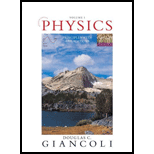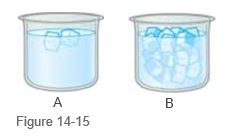
Physics: Principles with Applications
7th Edition
ISBN: 9780321625922
Author: Douglas C. Giancoli
Publisher: Addison-Wesley
expand_more
expand_more
format_list_bulleted
Textbook Question
Chapter 14, Problem 2MCQ
Both beakers A and B in Fig. 14-15 [□ contain a mixture of ice and water at equilibrium. Which beaker is the coldest, or are they equal in temperature?
- Beaker A.
- Beaker B.
- Equal

Expert Solution & Answer
Want to see the full answer?
Check out a sample textbook solution
Students have asked these similar questions
Will you please walk me through the calculations in more detail for solving this problem? I am a bit rusty on calculus and confused about the specific steps of the derivation: https://www.bartleby.com/solution-answer/chapter-3-problem-15e-modern-physics-2nd-edition/9780805303087/7cf8c31d-9476-46d5-a5a9-b897b16fe6fc
please help with the abstract. Abstract - This document outlines the format of the lab report and describes the Excel assignment. The abstract should be a short paragraph that very briefly includes the experiment objective, method, result and conclusion. After skimming the abstract, the reader should be able to decide whether they want to keep reading your work. Both the format of the report and the error analysis are to be followed. Note that abstract is not just the introduction and conclusion combined, but rather the whole experiment in short including the results. I have attacted the theory.
Using the Experimental Acceleration due to Gravity values from each data table, Data Tables 1, 2, and 3; determine the Standard Deviation, σ, mean, μ, variance, σ2 and the 95% Margin of Error (Confidence Level) Data: Ex. Acc. 1: 12.29 m/s^2. Ex. Acc. 2: 10.86 m/s^2, Ex. Acc. 3: 9.05 m/s^2
Chapter 14 Solutions
Physics: Principles with Applications
Ch. 14 - Prob. 1OQCh. 14 - Prob. 1QCh. 14 - Prob. 2QCh. 14 - (a) If two objects of different temperatures are...Ch. 14 - In warm regions where tropical plants grow but the...Ch. 14 - Prob. 5QCh. 14 - Prob. 6QCh. 14 - Prob. 7QCh. 14 - Prob. 8QCh. 14 - Prob. 9Q
Ch. 14 - Prob. 10QCh. 14 - 11. Explorers on failed Arctic expeditions have...Ch. 14 - Prob. 12QCh. 14 - Prob. 13QCh. 14 - Prob. 14QCh. 14 - Prob. 15QCh. 14 - Prob. 16QCh. 14 - Prob. 17QCh. 14 - Prob. 18QCh. 14 - Prob. 19QCh. 14 - Prob. 20QCh. 14 - Prob. 21QCh. 14 - A premature baby in an incubator can be...Ch. 14 - Prob. 23QCh. 14 - Prob. 24QCh. 14 - Prob. 25QCh. 14 - 26. The Earth cools off at night much more quickly...Ch. 14 - Prob. 27QCh. 14 - Prob. 28QCh. 14 - Prob. 29QCh. 14 - Prob. 1MCQCh. 14 - Both beakers A and B in Fig. 14-15 [ contain a...Ch. 14 - 3. For objects at thermal equilibrium, which of...Ch. 14 - Prob. 4MCQCh. 14 - Prob. 5MCQCh. 14 - Prob. 6MCQCh. 14 - Prob. 7MCQCh. 14 - Prob. 8MCQCh. 14 - Prob. 9MCQCh. 14 - Prob. 10MCQCh. 14 - Prob. 11MCQCh. 14 - Prob. 12MCQCh. 14 - To what temperature will 8200 J of heat raise 3.0...Ch. 14 - How much heat (in joules) is required to raise the...Ch. 14 - Prob. 3PCh. 14 - An average active person consumes about 2500 Cal a...Ch. 14 - A British thermal unit (Btu) is a unit of heat in...Ch. 14 - How many joules and kilocalories are generated...Ch. 14 - A water heater can generate 32,000 kJ/h. How much...Ch. 14 - Prob. 8PCh. 14 - An automobile cooling system holds 18 L of water....Ch. 14 - What is the specific heat of a metal substance if...Ch. 14 - (a) How much energy is required to bring a 1.0-L...Ch. 14 - Prob. 12PCh. 14 - How long does it take a 750-W coffeepot to bring...Ch. 14 - 14. (II) What will be the equilibrium temperature...Ch. 14 - A 31.5-g glass thermometer reads 23.6°C before it...Ch. 14 - A 0.40-kg iron horseshoe, just forged and very hot...Ch. 14 - Prob. 17PCh. 14 - The heat capacity, C, ofan object is defined as...Ch. 14 - Prob. 19PCh. 14 - Prob. 20PCh. 14 - Prob. 21PCh. 14 - Estimate the Calorie content of 65 g of candy from...Ch. 14 - Prob. 23PCh. 14 - If 3.40 x 105 J of energy is supplied to a...Ch. 14 - How much heat is needed to melt 23.50 kg of silver...Ch. 14 - Prob. 26PCh. 14 - What mass of steam at 100°C must be added to 1.00...Ch. 14 - Prob. 28PCh. 14 - Prob. 29PCh. 14 - Prob. 30PCh. 14 - Prob. 31PCh. 14 - Prob. 32PCh. 14 - Prob. 33PCh. 14 - A cube of ice is taken from the freezer at -8.5°C...Ch. 14 - Prob. 35PCh. 14 - Prob. 36PCh. 14 - Prob. 37PCh. 14 - Prob. 38PCh. 14 - 39. How long does it take the Sun to melt a block...Ch. 14 - Prob. 40PCh. 14 - Two rooms, each a cube 4.0 m per side, share a...Ch. 14 - Prob. 42PCh. 14 - Approximately how long should it take 8.2 kg of...Ch. 14 - Prob. 44PCh. 14 - Suppose the insulating qualities of the wall of a...Ch. 14 - Prob. 46GPCh. 14 - (a) Estimate the total power radiated into space...Ch. 14 - Prob. 48GPCh. 14 - Prob. 49GPCh. 14 - A mountain climber wears a goose-down jacket 3.5...Ch. 14 - Prob. 51GPCh. 14 - Prob. 52GPCh. 14 - Prob. 53GPCh. 14 - Prob. 54GPCh. 14 - Prob. 55GPCh. 14 - Prob. 56GPCh. 14 - Prob. 57GPCh. 14 - Prob. 58GPCh. 14 - Prob. 59GPCh. 14 - Prob. 60GPCh. 14 - Prob. 61GPCh. 14 - Prob. 62GPCh. 14 - Prob. 63GPCh. 14 - Prob. 64GPCh. 14 - A leaf of area 40 cm2and mass 4.5 x 10-4kg...Ch. 14 - Prob. 66GPCh. 14 - Prob. 67GPCh. 14 - Prob. 68GP
Knowledge Booster
Learn more about
Need a deep-dive on the concept behind this application? Look no further. Learn more about this topic, physics and related others by exploring similar questions and additional content below.Similar questions
- In the Super Smash Bros. games the character Yoshi’s has a “ground pound” down special move where he launches himself downward to attack an enemy beneath him. A) If Yoshi flings himself downwards at 9.76 miles per hour to hit an enemy 10.5 m below him, how fast is Yoshi traveling when he hits the enemy? 1 mile = 1609 m B) How much time does it take Yoshi to hit the enemy beneath him?arrow_forwardNo chatgpt pls will upvotearrow_forwardSolve No chatgpt pls will upvotearrow_forward
- Can someone help me solve this thank you.arrow_forwardNo chatgpt pls will upvotearrow_forward1.62 On a training flight, a Figure P1.62 student pilot flies from Lincoln, Nebraska, to Clarinda, Iowa, next to St. Joseph, Missouri, and then to Manhattan, Kansas (Fig. P1.62). The directions are shown relative to north: 0° is north, 90° is east, 180° is south, and 270° is west. Use the method of components to find (a) the distance she has to fly from Manhattan to get back to Lincoln, and (b) the direction (relative to north) she must fly to get there. Illustrate your solutions with a vector diagram. IOWA 147 km Lincoln 85° Clarinda 106 km 167° St. Joseph NEBRASKA Manhattan 166 km 235° S KANSAS MISSOURIarrow_forward
- Plz no chatgpt pls will upvotearrow_forward3.19 • Win the Prize. In a carnival booth, you can win a stuffed gi- raffe if you toss a quarter into a small dish. The dish is on a shelf above the point where the quarter leaves your hand and is a horizontal dis- tance of 2.1 m from this point (Fig. E3.19). If you toss the coin with a velocity of 6.4 m/s at an angle of 60° above the horizontal, the coin will land in the dish. Ignore air resistance. (a) What is the height of the shelf above the point where the quarter leaves your hand? (b) What is the vertical component of the velocity of the quarter just before it lands in the dish? Figure E3.19 6.4 m/s 2.1arrow_forwardCan someone help me answer this thank you.arrow_forward
- 1.21 A postal employee drives a delivery truck along the route shown in Fig. E1.21. Determine the magnitude and direction of the resultant displacement by drawing a scale diagram. (See also Exercise 1.28 for a different approach.) Figure E1.21 START 2.6 km 4.0 km 3.1 km STOParrow_forwardhelp because i am so lost and it should look something like the picturearrow_forward3.31 A Ferris wheel with radius Figure E3.31 14.0 m is turning about a horizontal axis through its center (Fig. E3.31). The linear speed of a passenger on the rim is constant and equal to 6.00 m/s. What are the magnitude and direction of the passenger's acceleration as she passes through (a) the lowest point in her circular motion and (b) the high- est point in her circular motion? (c) How much time does it take the Ferris wheel to make one revolution?arrow_forward
arrow_back_ios
SEE MORE QUESTIONS
arrow_forward_ios
Recommended textbooks for you
 College PhysicsPhysicsISBN:9781305952300Author:Raymond A. Serway, Chris VuillePublisher:Cengage Learning
College PhysicsPhysicsISBN:9781305952300Author:Raymond A. Serway, Chris VuillePublisher:Cengage Learning College PhysicsPhysicsISBN:9781285737027Author:Raymond A. Serway, Chris VuillePublisher:Cengage Learning
College PhysicsPhysicsISBN:9781285737027Author:Raymond A. Serway, Chris VuillePublisher:Cengage Learning Glencoe Physics: Principles and Problems, Student...PhysicsISBN:9780078807213Author:Paul W. ZitzewitzPublisher:Glencoe/McGraw-Hill
Glencoe Physics: Principles and Problems, Student...PhysicsISBN:9780078807213Author:Paul W. ZitzewitzPublisher:Glencoe/McGraw-Hill
 Physics for Scientists and Engineers: Foundations...PhysicsISBN:9781133939146Author:Katz, Debora M.Publisher:Cengage Learning
Physics for Scientists and Engineers: Foundations...PhysicsISBN:9781133939146Author:Katz, Debora M.Publisher:Cengage Learning College PhysicsPhysicsISBN:9781938168000Author:Paul Peter Urone, Roger HinrichsPublisher:OpenStax College
College PhysicsPhysicsISBN:9781938168000Author:Paul Peter Urone, Roger HinrichsPublisher:OpenStax College

College Physics
Physics
ISBN:9781305952300
Author:Raymond A. Serway, Chris Vuille
Publisher:Cengage Learning

College Physics
Physics
ISBN:9781285737027
Author:Raymond A. Serway, Chris Vuille
Publisher:Cengage Learning

Glencoe Physics: Principles and Problems, Student...
Physics
ISBN:9780078807213
Author:Paul W. Zitzewitz
Publisher:Glencoe/McGraw-Hill


Physics for Scientists and Engineers: Foundations...
Physics
ISBN:9781133939146
Author:Katz, Debora M.
Publisher:Cengage Learning

College Physics
Physics
ISBN:9781938168000
Author:Paul Peter Urone, Roger Hinrichs
Publisher:OpenStax College
Thermal Expansion and Contraction of Solids, Liquids and Gases; Author: Knowledge Platform;https://www.youtube.com/watch?v=9UtfegG4DU8;License: Standard YouTube License, CC-BY